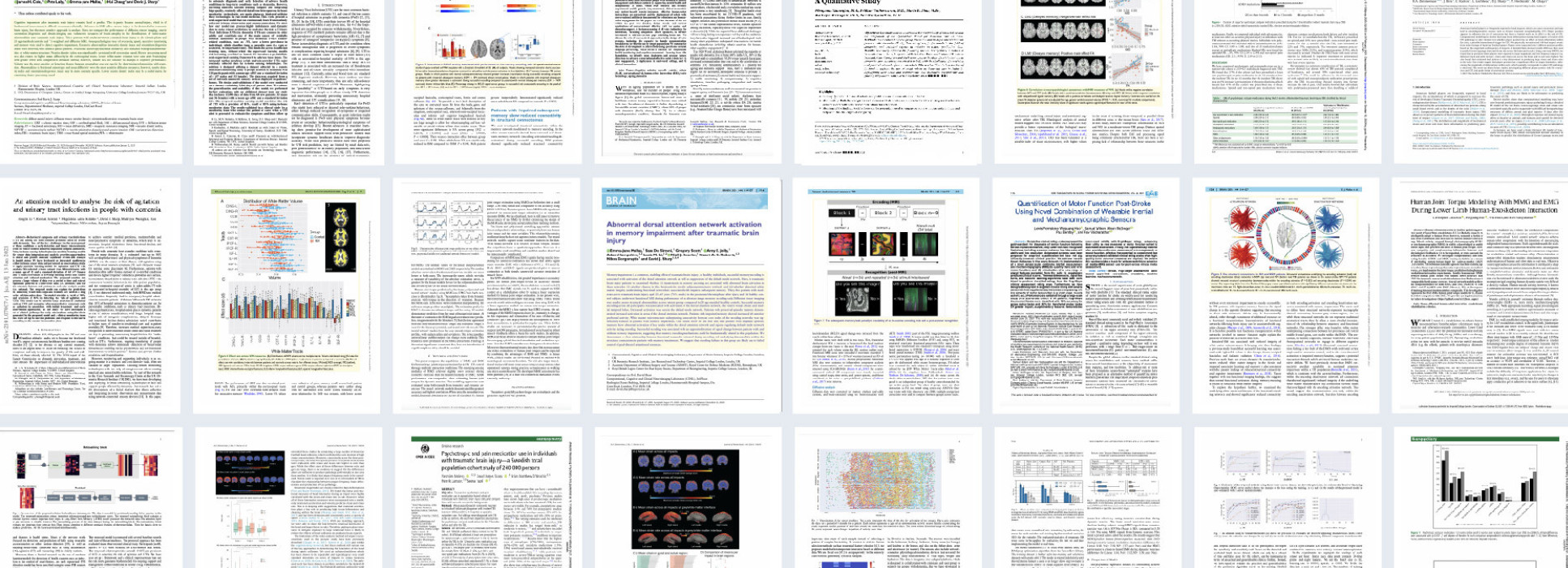
Results
- Showing results for:
- Reset all filters
Search results
-
Journal articleGorgoraptis N, Zaw-Linn J, Feeney C, et al., 2019,
Cognitive impairment and health- related quality of life following traumatic brain injury
, Journal of Alzheimer's Disease, Vol: 44, Pages: 321-331, ISSN: 1387-2877BACKGROUNDCognitive impairment is a common and disabling consequence of traumatic brain injury (TBI) but its impact on health-related quality of life is not well understood.OBJECTIVETo investigate the relationship between cognitive impairment and health-related quality of life (HRQoL) after TBI.METHODSRetrospective, cross-sectional study of a specialist TBI outpatient clinic patient sample. Outcome measures: Addenbrooke's Cognitive Examination Tool - Revised (ACE-R), and SF-36 quality of life, Beck Depression Inventory II (BDI-II), Pittsburgh Sleep Quality Index (PSQI) and Epworth Sleepiness Scale (ESS) questionnaires.RESULTS240 adults were assessed: n = 172 (71.7% ) moderate-severe, 41 (23.8% ) mild, 27 (11.3% ) symptomatic TBI, 174 (72.5% ) male, median age (range): 44 (22-91) years. TBI patients reported poorer scores on all domains of SF-36 compared to age-matched UK normative data. Cognitively impaired patients reported poorer HRQoL on the physical, social role and emotional role functioning, and mental health domains. Cognitive impairment predicted poorer HRQoL on the social and emotional role functioning domains, independently of depressive symptoms, sleep disturbance, daytime sleepiness and TBI severity. Mediation analysis revealed that the effect of depressive symptoms on the emotional role functioning domain of HRQoL was partially mediated by cognitive dysfunction.CONCLUSIONCognitive impairment is associated with worse health-related quality of life after TBI and partially mediates the effect of depressive symptoms on emotional role functioning.
-
Conference paperAhmadi N, Cavuto ML, Feng P, et al., 2019,
Towards a distributed, chronically-implantable neural interface
, 9th IEEE/EMBS International Conference on Neural Engineering (NER), Publisher: IEEE, Pages: 719-724, ISSN: 1948-3546We present a platform technology encompassing a family of innovations that together aim to tackle key challenges with existing implantable brain machine interfaces. The ENGINI (Empowering Next Generation Implantable Neural Interfaces) platform utilizes a 3-tier network (external processor, cranial transponder, intracortical probes) to inductively couple power to, and communicate data from, a distributed array of freely-floating mm-scale probes. Novel features integrated into each probe include: (1) an array of niobium microwires for observing local field potentials (LFPs) along the cortical column; (2) ultra-low power instrumentation for signal acquisition and data reduction; (3) an autonomous, self-calibrating wireless transceiver for receiving power and transmitting data; and (4) a hermetically-sealed micropackage suitable for chronic use. We are additionally engineering a surgical tool, to facilitate manual and robot-assisted insertion, within a streamlined neurosurgical workflow. Ongoing work is focused on system integration and preclinical testing.
-
Journal articleEnshaeifar S, Zoha A, Skillman S, et al., 2019,
Machine learning methods for detecting urinary tract infection and analysing daily living activities in people with dementia
, PLoS One, Vol: 14, ISSN: 1932-6203Dementia is a neurological and cognitive condition that affects millions of people around the world. At any given time in the United Kingdom, 1 in 4 hospital beds are occupied by a person with dementia, while about 22% of these hospital admissions are due to preventable causes. In this paper we discuss using Internet of Things (IoT) technologies and in-home sensory devices in combination with machine learning techniques to monitor health and well-being of people with dementia. This will allow us to provide more effective and preventative care and reduce preventable hospital admissions. One of the unique aspects of this work is combining environmental data with physiological data collected via low cost in-home sensory devices to extract actionable information regarding the health and well-being of people with dementia in their own home environment. We have worked with clinicians to design our machine learning algorithms where we focused on developing solutions for real-world settings. In our solutions, we avoid generating too many alerts/alarms to prevent increasing the monitoring and support workload. We have designed an algorithm to detect Urinary Tract Infections (UTI) which is one of the top five reasons of hospital admissions for people with dementia (around 9% of hospital admissions for people with dementia in the UK). To develop the UTI detection algorithm, we have used a Non-negative Matrix Factorisation (NMF) technique to extract latent factors from raw observation and use them for clustering and identifying the possible UTI cases. In addition, we have designed an algorithm for detecting changes in activity patterns to identify early symptoms of cognitive decline or health decline in order to provide personalised and preventative care services. For this purpose, we have used an Isolation Forest (iForest) technique to create a holistic view of the daily activity patterns. This paper describes the algorithms and discusses the evaluation of the work using a lar
-
Conference paperNilforooshan R, Rostill H, Barnaghi P, et al., 2019,
Transforming care for people with dementia using the Internet of Things
, Publisher: UBIQUITY PRESS LTD, ISSN: 1568-4156- Author Web Link
- Cite
- Citations: 3
-
Conference paperDe Marcellis A, Di Patrizio Stanchieri G, Palange E, et al., 2018,
An ultra-wideband-inspired system-on-chip for an optical bidirectional transcutaneous biotelemetry
, IEEE Biomedical Circuits and Systems (BioCAS) Conference 2018, Publisher: IEEE, Pages: 351-354This paper describes an integrated communicationsystem, implementing a UWB-inspired pulsed coding technique,for an optical transcutaneous biotelemetry. The system consistsof both a transmitter and a receiver facilitating a bidirectionallink. The transmitter includes a digital data coding circuit and iscapable of generating sub-nanosecond current pulses and directlydriving an off-chip semiconductor laser diode including all biasand drive circuits. The receiver includes an integrated compactPN-junction photodiode together with signal conditioning, de-tection and digital data decoding circuits to enable a high bitrate, energy efficient communication. The proposed solution hasbeen implemented in a commercially available 0.35μm CMOStechnology provided by AMS. The circuit core occupies a compactsilicon footprint of less than 0.13 mm2(only 113 transistors and1 resistor). Post-layout simulations have validated the overallsystem operation demonstrating the ability to operate at bit ratesup to 500 Mbps with pulse widths of 300 ps with a total powerefficiency (transmitter + receiver) lower than 74 pJ/bit. Thismakes the system ideally suited for demanding applications thatrequire high bit rates at extremely low energy levels. One suchapplication is implantable brain machine interfaces requiringhigh uplink bitrates to transmit recorded data externally througha transcutaneous communication channel.
This data is extracted from the Web of Science and reproduced under a licence from Thomson Reuters. You may not copy or re-distribute this data in whole or in part without the written consent of the Science business of Thomson Reuters.
Awards
- Finalist: Best Paper - IEEE Transactions on Mechatronics (awarded June 2021)
- Finalist: IEEE Transactions on Mechatronics; 1 of 5 finalists for Best Paper in Journal
- Winner: UK Institute of Mechanical Engineers (IMECHE) Healthcare Technologies Early Career Award (awarded June 2021): Awarded to Maria Lima (UKDRI CR&T PhD candidate)
- Winner: Sony Start-up Acceleration Program (awarded May 2021): Spinout company Serg Tech awarded (1 of 4 companies in all of Europe) a place in Sony corporation start-up boot camp
- “An Extended Complementary Filter for Full-Body MARG Orientation Estimation” (CR&T authors: S Wilson, R Vaidyanathan)

Established in 2017 by its principal funder the Medical Research Council, in partnership with Alzheimer's Society and Alzheimer’s Research UK, The UK Dementia Research Institute (UK DRI) is the UK’s leading biomedical research institute dedicated to neurodegenerative diseases.


